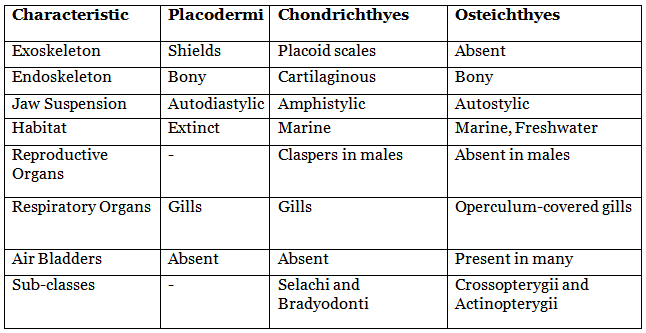UPSC Exam > UPSC Notes > Zoology Optional Notes for UPSC > Pisces: Overview
Pisces: Overview | Zoology Optional Notes for UPSC PDF Download
| Table of contents |

|
| Introduction to Pisces |

|
| Characteristics of Pisces |

|
| Classification of Pisces |

|
| Key Differences Between Pisces Classes |

|
Introduction to Pisces
Pisces are ectothermic vertebrates that rely on gills for respiration and predominantly inhabit aquatic environments. They exhibit a wide range of body shapes, including streamlined, elongated, and dorsoventrally flattened forms, often characterized by the presence of paired and unpaired fins supported by soft or spiny fin rays.
Characteristics of Pisces
- Habitat Diversity: Pisces are adaptable to various aquatic environments, including freshwater, marine, and brackish water.
- Body Shape: They commonly have a streamlined body, although some species exhibit spindle-shaped or elongated forms.
- Body Division: The body is divided into distinct regions: head, trunk, and tail.
- Locomotion: Swimming is primarily facilitated by the tail, a crucial locomotor structure.
- Fins: Paired and unpaired fins serve as appendages that aid in balance and maneuverability.
- Lateral Line System: Pisces possess a lateral line system, functioning as a sensory organ to detect disturbances in the surrounding environment.
- Scale Protection: The body is covered in thick-seated scales, which offer protection to internal organs.
- Respiration: Gills serve as respiratory organs, allowing Pisces to extract oxygen from water.
- Circulation: They exhibit closed-type blood circulation.
- Skeletal Diversity: Pisces may have bony or cartilaginous internal skeletons.
- Ectothermic Nature: Pisces are cold-blooded organisms, meaning their body temperature is regulated by the environment.
- Feeding Habits: They can be herbivores or carnivores, and reproduction can be oviparous or ovoviviparous.
- Sexual Dimorphism: Pisces have separate sexes.
- Fertilization: Fertilization can be external or internal.
- Embryonic Features: They lack extra-embryonic membranes.
- Digestive System: Pisces have a well-developed digestive system.
 Torpedo
Torpedo
Classification of Pisces
Pisces are classified into three main categories based on their characteristics:
Placodermi (Aphstohyoids)
- All members of this class are now extinct.
- They had an exoskeleton in the form of shields and a bony endoskeleton.
- Autodiastylic jaw suspension was a characteristic feature.
- Placoderms survived until the end of the Devonian period.
- Heterocercal caudal fin was present.
- Examples include Climatius and Bothriolepis.
- These fish are exclusively found in marine environments.
- They possess an exoskeleton composed of placoid scales.
- The endoskeleton is cartilaginous.
- Jaw suspension follows the amphistylic pattern.
- Gills serve as their respiratory organs.
- They exhibit a heterocercal caudal fin.
- Males have claspers as reproductive organs.
- Air bladders are absent.
- Chondrichthyes are divided into two sub-classes: Selachi and Bradyodonti.
- Osteichthyes are found in marine, freshwater, and brackish water environments.
- They possess a bony endoskeleton.
- Autostylic jaw suspension is a defining feature.
- Claspers are absent in males.
- Gills are covered by an operculum.
- Many species have air bladders.
- They are further categorized into two sub-classes: Crossopterygii and Actinopterygii.
- Examples include Proptopterus and Lepidosiren.

 |
Download the notes
Pisces: Overview
|
Download as PDF |
Download as PDF
Key Differences Between Pisces Classes

These differences highlight the distinctive features of each class within the Pisces group, aiding in their taxonomic classification.
The document Pisces: Overview | Zoology Optional Notes for UPSC is a part of the UPSC Course Zoology Optional Notes for UPSC.
All you need of UPSC at this link: UPSC
|
181 videos|346 docs
|
Related Searches





















